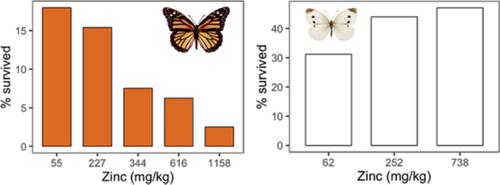当前位置:
X-MOL 学术
›
Insect Conserv. Divers.
›
论文详情
Our official English website, www.x-mol.net, welcomes your
feedback! (Note: you will need to create a separate account there.)
Assessing zinc tolerance in two butterfly species: consequences for conservation in polluted environments
Insect Conservation and Diversity ( IF 3.2 ) Pub Date : 2020-03-04 , DOI: 10.1111/icad.12404 Alexander M. Shephard 1 , Timothy S. Mitchell 1 , Sara B. Henry 1 , Karen S. Oberhauser 2 , Megan E. Kobiela , Emilie C. Snell‐Rood 1
中文翻译:

评估两种蝴蝶的锌耐受性:在污染环境中保护的后果
更新日期:2020-03-04
Insect Conservation and Diversity ( IF 3.2 ) Pub Date : 2020-03-04 , DOI: 10.1111/icad.12404 Alexander M. Shephard 1 , Timothy S. Mitchell 1 , Sara B. Henry 1 , Karen S. Oberhauser 2 , Megan E. Kobiela , Emilie C. Snell‐Rood 1
Affiliation

|
- Zinc is a widespread pollutant released from industrial combustion, automobile residue, and mining. Zinc accumulates in soils and mobilises into plant tissue where it may be consumed to potentially toxic levels by leaf feeding insects, including developing pollinators.
- While zinc tolerance thresholds have been previously assessed in insect pollinators, most observations are limited to model organisms and pest species. We lack understanding of zinc tolerance in insects of conservation concern.
- We assess dietary zinc tolerance of developing caterpillars from wild populations of the monarch butterfly (Danaus plexippus), a species of conservation concern, whose caterpillars are commonly exposed to elevated dietary zinc exposure in milkweed plants along roadsides. We contrast monarch zinc tolerance with that of cabbage white butterfly caterpillars (Pieris rapae), a non‐native pest species. Tolerance was assessed by rearing caterpillars on artificial diets containing varying levels of zinc.
- Zinc reduced monarch survival at levels as low as 344 mg kg−1 but positively impacted cabbage white survival at 227 and 738 mg kg−1. Cabbage whites also displayed prolonged development time, smaller adult body size, and slower growth rate, consistent with the possibility that zinc tolerance had fitness costs.
- Our results support previous observations that heavy metal tolerance varies between species and highlight the importance of broadening our understanding of tolerance to insect species of conservation concern before drawing general conclusions about insect susceptibility to heavy metal pollution. Nonetheless, our results suggest that zinc pollution alone is unlikely a risk in developing roadside habitat for monarch butterflies.
中文翻译:

评估两种蝴蝶的锌耐受性:在污染环境中保护的后果
- 锌是从工业燃烧,汽车残渣和采矿中释放出来的广泛污染物。锌在土壤中积累,并迁移到植物组织中,在那里,包括昆虫的授粉媒介在内的食叶昆虫可能会将其消耗到潜在的有毒水平。
- 虽然以前已经在昆虫授粉媒介中评估了锌耐受性阈值,但大多数观察仅限于模型生物和害虫物种。我们缺乏对具有保护意义的昆虫中锌耐受性的了解。
- 我们评估了帝王蝶(Danaus plexippus)的野生种群中发展中的毛毛虫的饮食锌耐受性,这是一种值得关注的物种,其毛毛虫通常在路旁的乳草植物中暴露于高饮食锌暴露水平。我们将帝王对锌的耐受性与非本地害虫物种白菜白蝴蝶毛毛虫(Pieris rapae)进行了对比。通过在含有不同水平锌的人工饮食中饲养毛毛虫来评估耐受性。
- 锌将君主的存活率降低至344 mg kg -1,但对白菜白的存活率分别为227和738 mg kg -1产生积极影响。白菜白还显示出延长的发育时间,较小的成年体形和较慢的生长速度,这与耐锌性具有健身成本的可能性一致。
- 我们的结果支持以前关于物种对重金属的耐受性不同的观察结果,并强调了在得出关于昆虫对重金属污染的敏感性的一般结论之前,扩大我们对具有保护意义的昆虫物种的耐受性的认识的重要性。尽管如此,我们的结果表明,仅锌污染不太可能成为帝王蝶在路边栖息地发展的风险。











































 京公网安备 11010802027423号
京公网安备 11010802027423号